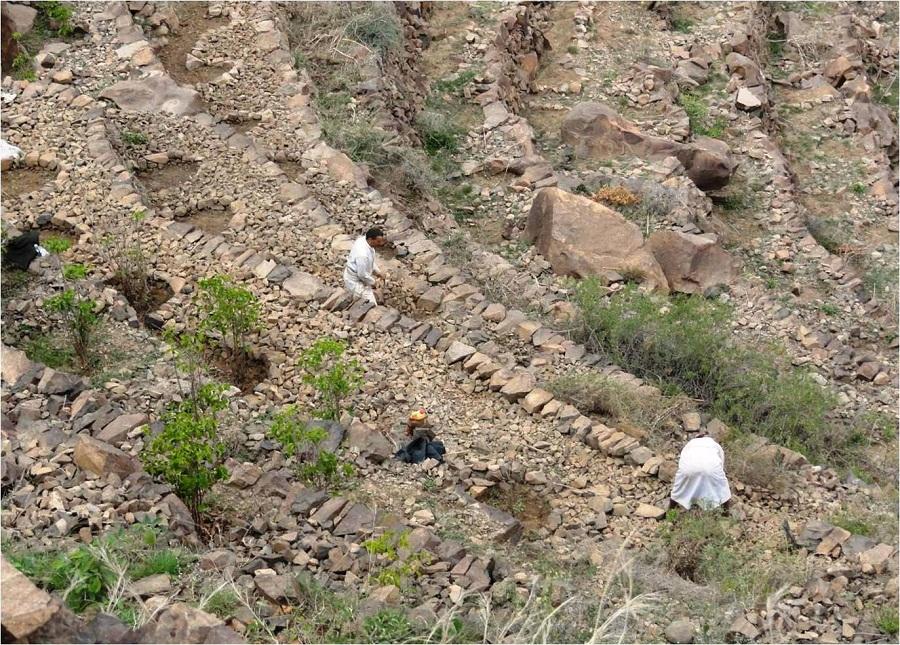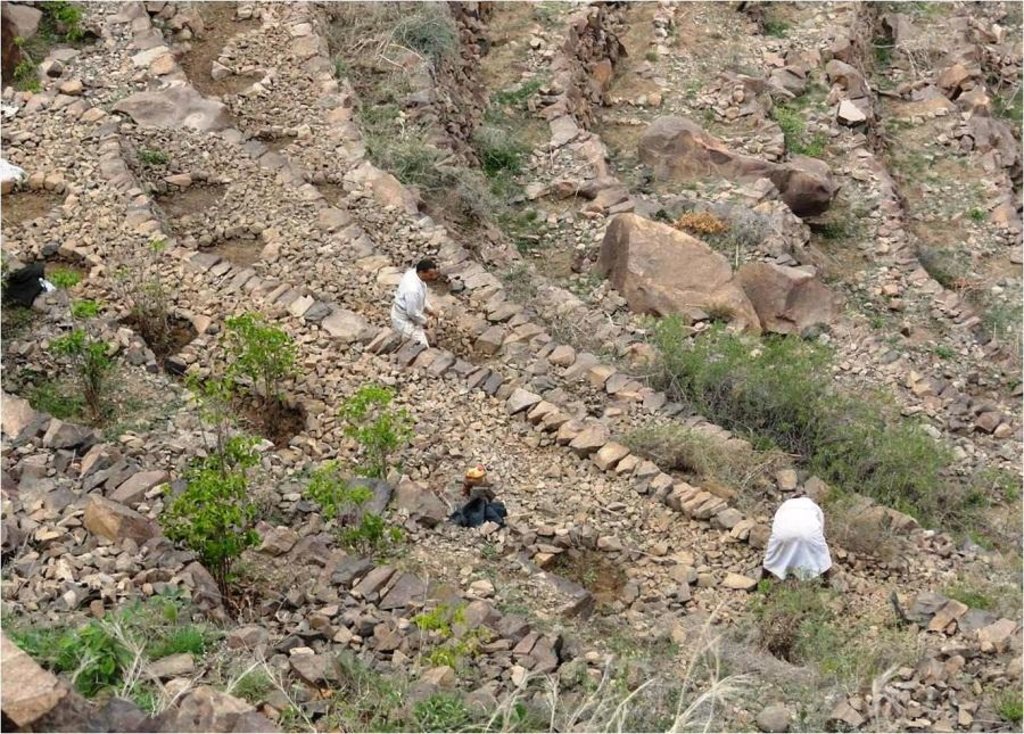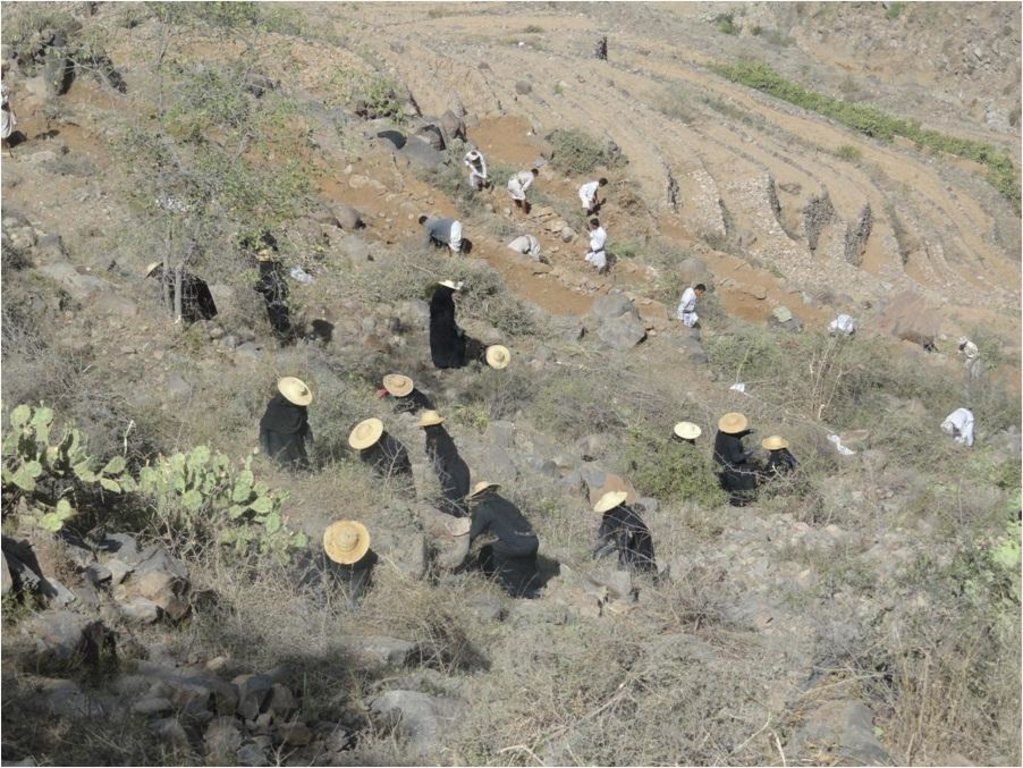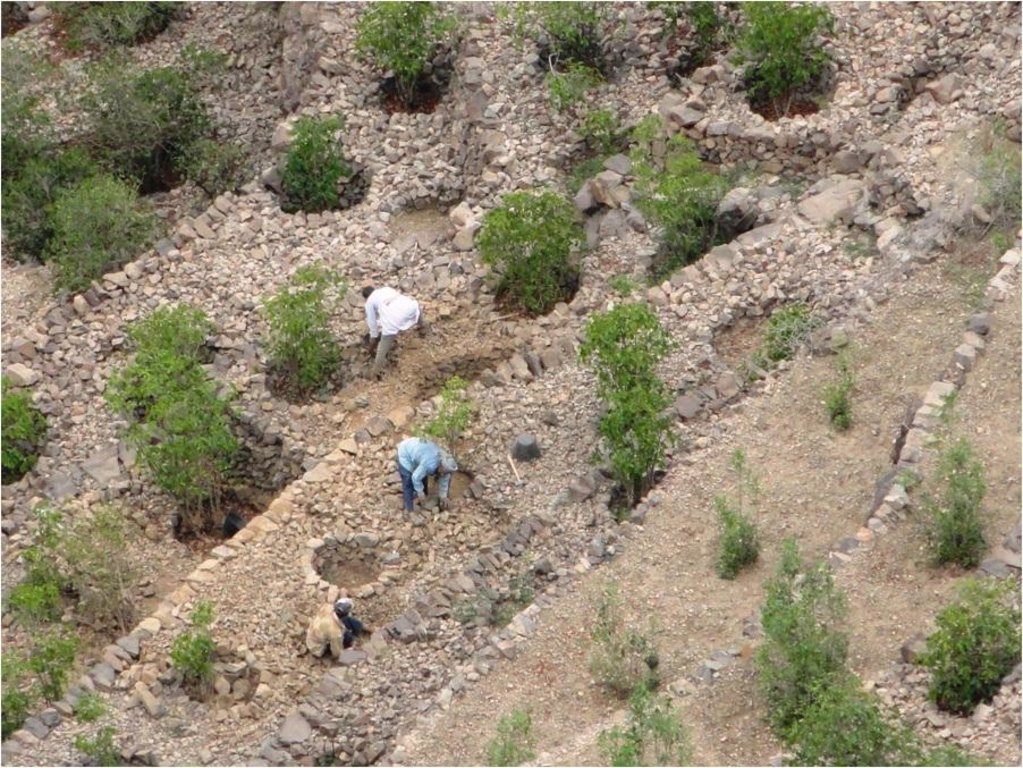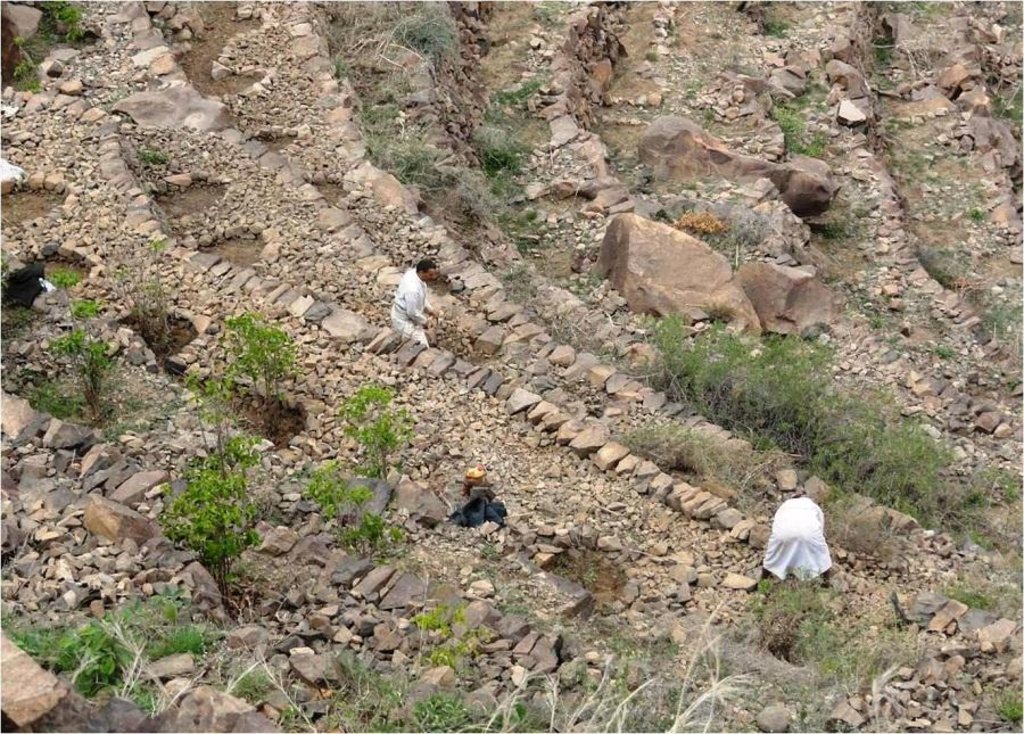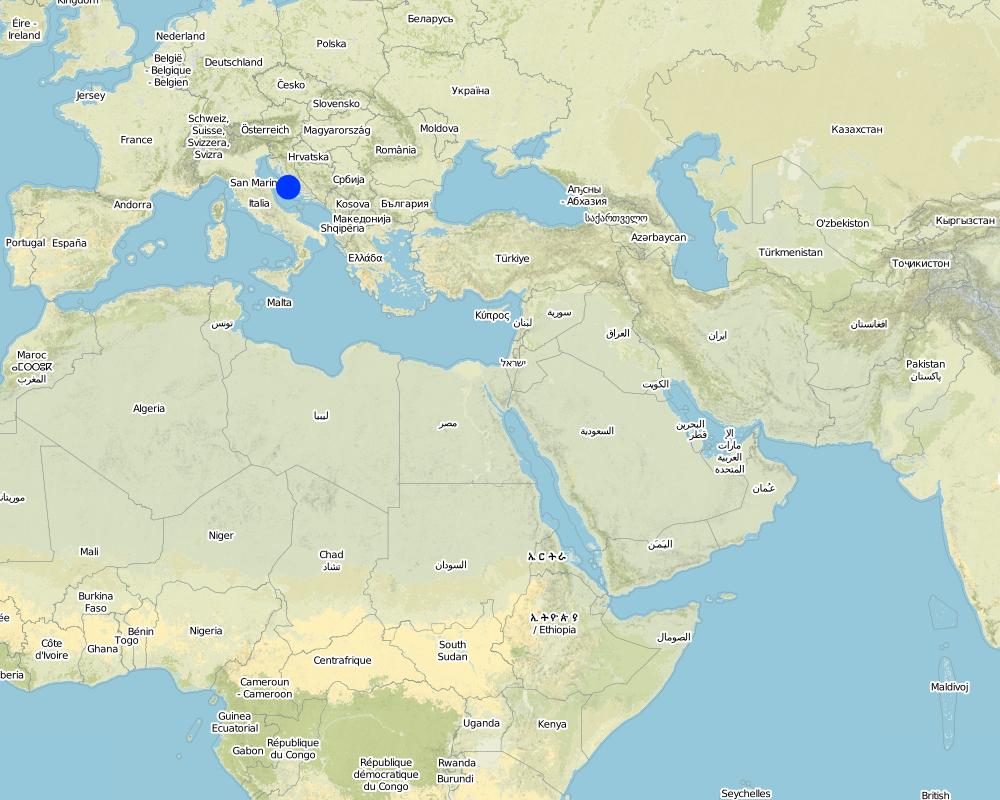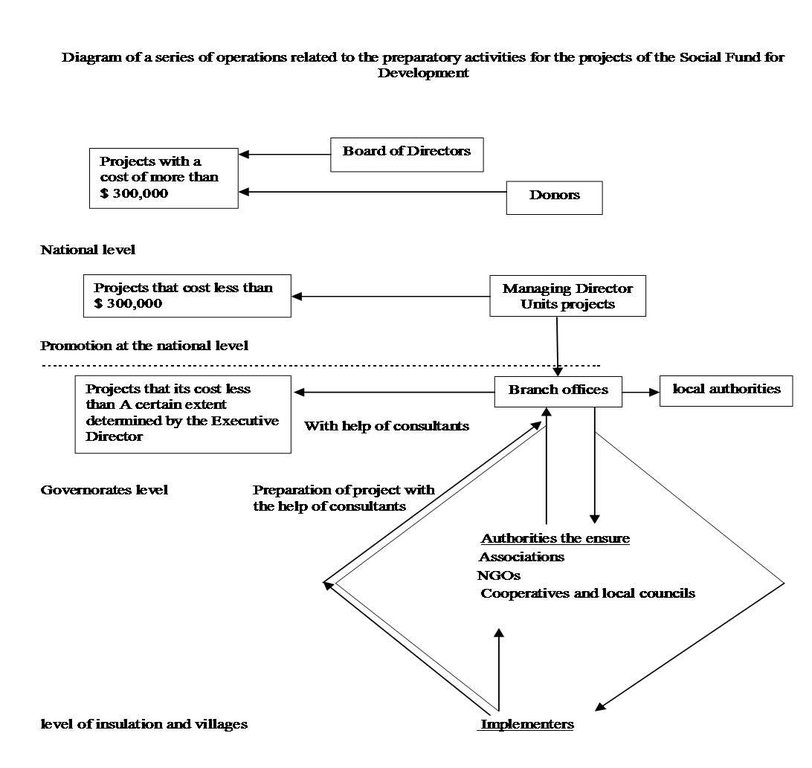Building and rehabilitation of agricultural terraces. [Yemen]
- Creation:
- Update:
- Compiler: ahmed algalal
- Editor: –
- Reviewer: Fabian Ottiger
بناء وإعادة تأهيل المدرجات الزراعية
approaches_2586 - Yemen
View sections
Expand all Collapse all1. General information
1.2 Contact details of resource persons and institutions involved in the assessment and documentation of the Approach
SLM specialist:
Ibrahem Abdullah
00967777595480
Agricultural Research and Extension Authority, AREA
Yemen
Name of the institution(s) which facilitated the documentation/ evaluation of the Approach (if relevant)
Agricultural Research and Extension Authority (AREA) - Yemen1.3 Conditions regarding the use of data documented through WOCAT
When were the data compiled (in the field)?
20/02/2013
The compiler and key resource person(s) accept the conditions regarding the use of data documented through WOCAT:
Ja
1.4 Reference(s) to Questionnaire(s) on SLM Technologies
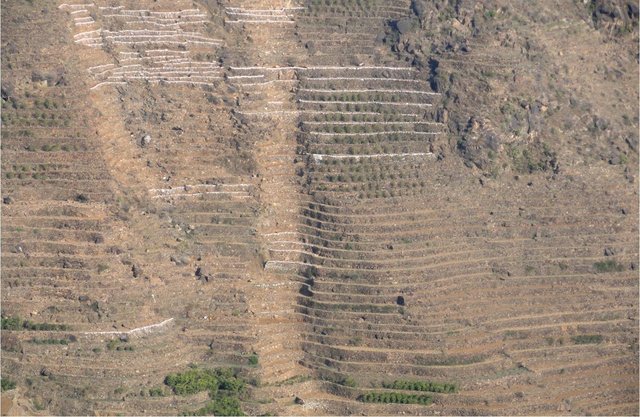
Bench terraces covered with small stones [Yemen]
Building terraces in steep areas for the purpose of reducing the slope, water harvesting and soil moisture conservation.
- Compiler: ahmed algalal
2. Description of the SLM Approach
2.1 Short description of the Approach
Pay incentives for farmers rehabilitate degraded terraces in order to face the crisis of increasing food prices.
2.2 Detailed description of the Approach
Detailed description of the Approach:
Aims / objectives: The main objective is to rehabilitate the degraded terraces and to protect them from erosion through the payment of incentives. Conservation of land resources should be achieved through cooperation between the land users applying local knowledge and traditional practices for soil conservation. Through this, the livelihoods of land users are improved and it helps them to continue their farming operations which helps to alleviate poverty. Through the Social Development Fund the state aims to improve community development through a comprehensive concept and to address the crisis of rising food prices. Through this fund land users receive support for their physical work. The rehabilitated terraces will later help them to improve their agricultural income The project interferes in the region through the involvement of land users (from bottom to top). To help them solve their problems, a study of the region’s problems using Participatory Rapid Rural Appraisal (PRA) and a Participatory Learning Approach (PLA) was conducted. With the participation of the community problems and constraints were identified and appropriate solutions developed, as well as priorities identified for intervention. An inventory of households was done by a dedicated team to determine the costs and the appropriate methods for the implementation process and the mechanisms used for the implementation. Furthermore awareness rising was carried out. After completion of the technical study and determination of the costs, the areas where the activities should be implemented were assigned to a specialist. After the technical study is finished and the cost of implementing for the targeted area is determined and allocated. Then Social Fund for Development office SFD appoints specialized person to follow up the implemented activities ,which usually carry out by the land users and as long as they finished the implemented activities they should receives their money (this the explanation of SDF and receivables). It should be noted that there is a lack of funding all the degraded areas, so that the SFD select only the degraded areas which are their owner unable to rehabilitate them.
2.3 Photos of the Approach
2.5 Country/ region/ locations where the Approach has been applied
Country:
Yemen
Region/ State/ Province:
Sana'a governorate
Further specification of location:
Bani Ismail- Manakha District
Map
×2.6 Dates of initiation and termination of the Approach
Indicate year of initiation:
2010
Year of termination (if Approach is no longer applied):
2011
2.7 Type of Approach
- project/ programme based
2.8 Main aims/ objectives of the Approach
The Approach focused mainly on SLM with other activities (Facing increasing food prices i.e. Money against work.)
Rebuilding the degraded terraces and protect them from degradation
The SLM Approach addressed the following problems: Lack of money for implementing terraces, poverty.
2.9 Conditions enabling or hindering implementation of the Technology/ Technologies applied under the Approach
availability/ access to financial resources and services
- hindering
Not enough finances available.
Treatment through the SLM Approach: Supporting land users with funds (money against work).
legal framework (land tenure, land and water use rights)
- enabling
The existing land ownership, land use rights / water rights greatly helped the approach implementation: Initiate all land users in rehabilitating the degraded terraces without any conflict as long as they believe of work together and with spirit team work.
3. Participation and roles of stakeholders involved
3.1 Stakeholders involved in the Approach and their roles
- local land users/ local communities
Both gender men and women. Men have more experience and more power for work than the women. Women carried out the weeding in the field in addition to food preparation at home.
- SLM specialists/ agricultural advisers
- national government (planners, decision-makers)
3.2 Involvement of local land users/ local communities in the different phases of the Approach
| Involvement of local land users/ local communities | Specify who was involved and describe activities | |
|---|---|---|
| initiation/ motivation | interactive | Identified the problems, suggested solutions and determined the priority for implementation – local community |
| planning | interactive | |
| implementation | interactive | Land users carried out all the implementation under the supervision of supporting donors. |
| monitoring/ evaluation | none | |
| Research | none |
3.3 Flow chart (if available)
Description:
Diagram of a series of operations related to the preparatory activities for projects the Social Fund for Development
Author:
(Sana'a)
3.4 Decision-making on the selection of SLM Technology/ Technologies
Specify who decided on the selection of the Technology/ Technologies to be implemented:
- land users alone (self-initiative)
Explain:
It is a traditional technology and still exist but it needs maintenance.
Decisions on the method of implementing the SLM Technology were made by mainly by land users supported by SLM specialists. The approach for implementation can be done by consulting and discussing it with the land users.
4. Technical support, capacity building, and knowledge management
4.1 Capacity building/ training
Was training provided to land users/ other stakeholders?
Ja
Specify who was trained:
- land users
Form of training:
- Meetings
Subjects covered:
Awareness campaign to increase the importance on preserving land and conserving it to avoid any damages as a result of degradation as then it becomes difficult to repair it by the land users. Finally, this situation will lead to land abandonment and emigration.
4.2 Advisory service
Do land users have access to an advisory service?
Ja
- Meetings
4.3 Institution strengthening (organizational development)
Have institutions been established or strengthened through the Approach?
- no
4.4 Monitoring and evaluation
Is monitoring and evaluation part of the Approach?
Ja
Comments:
technical aspects were regular monitored by project staff through measurements; indicators: None
socio-cultural aspects were regular monitored by project staff, land users through measurements; indicators: None
economic / production aspects were ad hoc monitored by project staff through observations; indicators: None
no. of land users involved aspects were regular monitored by project staff through measurements; indicators: None
bio-physical aspects were ad hoc monitored by project staff through observations; indicators: None
management of Approach aspects were regular monitored by project staff, land users through observations; indicators: None
There were few changes in the Approach as a result of monitoring and evaluation: Increase the target area
There were no changes in the Technology as a result of monitoring and evaluation: None
4.5 Research
Was research part of the Approach?
Nee
5. Financing and external material support
5.1 Annual budget for the SLM component of the Approach
If precise annual budget is not known, indicate range:
- 10,000-100,000
Comments (e.g. main sources of funding/ major donors):
Approach costs were met by the following donors: government (Labour (Money against work).): 100.0%
5.2 Financial/ material support provided to land users
Did land users receive financial/ material support for implementing the Technology/ Technologies?
Ja
If yes, specify type(s) of support, conditions, and provider(s):
Money against work
5.3 Subsidies for specific inputs (including labour)
If labour by land users was a substantial input, was it:
- paid in cash
Comments:
Conducting works by contracting
5.4 Credit
Was credit provided under the Approach for SLM activities?
Nee
6. Impact analysis and concluding statements
6.1 Impacts of the Approach
Did the Approach help land users to implement and maintain SLM Technologies?
- No
- Yes, little
- Yes, moderately
- Yes, greatly
Periodical maintenance is very important for terraces to protect them from degradation and conserving soil moisture as well.
Did other land users / projects adopt the Approach?
- No
- Yes, little
- Yes, moderately
- Yes, greatly
Did the Approach lead to improved livelihoods / human well-being?
- No
- Yes, little
- Yes, moderately
- Yes, greatly
Did the Approach help to alleviate poverty?
- No
- Yes, little
- Yes, moderately
- Yes, greatly
Rehabilitating degraded terraces bringing them back into production. Consequently alleviation of poverty.
6.2 Main motivation of land users to implement SLM
- increased production
Increase the amount of production
- environmental consciousness
- Decrease the emigration.
Provide livelihoods (re-construction of terraces)
- Protect the land from erosion.
6.3 Sustainability of Approach activities
Can the land users sustain what has been implemented through the Approach (without external support)?
- uncertain
If no or uncertain, specify and comment:
Lack of financial resources
6.4 Strengths/ advantages of the Approach
| Strengths/ advantages/ opportunities in the land user’s view |
|---|
| Use the available resources to rehabilitation of terraces. It means:'Rehabilitation of terraces should be depend on the existing materials in the region such as stones or water, and labour). |
| Strengths/ advantages/ opportunities in the compiler’s or other key resource person’s view |
|---|
| Work together in groups strengthens the social relationship between land users, which leads to increased initiative or motivation between them. Like this they are prepared to face any damage that may occur as a result to natural crisis such as climate change or drought. (How to sustain/ enhance this strength: Legislation should be implemented because it will lead to enhance the links between the local community and raise the work together in every business. it mean: 'It should be implemented and adopted ) |
6.5 Weaknesses/ disadvantages of the Approach and ways of overcoming them
| Weaknesses/ disadvantages/ risks in the compiler’s or other key resource person’s view | How can they be overcome? |
|---|---|
|
There are some regions which are still degraded and that have not been yet rehabilitated due to lack of financial resources |
Supporting farmers to rehabilitate the degraded land especially the terraces to achieve sustainable development and stop migration from rural areas to big cities. This can be done and to through alleviating poverty and at the same time preserving the limited land resources and utilized them in a sustainable way. |
7. References and links
7.1 Methods/ sources of information
- field visits, field surveys
- interviews with land users
7.2 References to available publications
Title, author, year, ISBN:
Technical study for construction and reclamation for terraces in some villages, Bani Ismail's uzlah, Manakhah district. Mid-monthly reports for implanting terraces construction in Bani Ismail's uzlah, Manakhah district.
Available from where? Costs?
- Social Fund for Development, Sana'a 97671449672- Social Fund for Development, Sana'a 97671449672
Title, author, year, ISBN:
Mid-monthly reports for implanting terraces construction in Bani Ismail's uzlah, Manakhah district.
Available from where? Costs?
Social Fund for Development, Sana'a 97671449672
Links and modules
Expand all Collapse allLinks

Bench terraces covered with small stones [Yemen]
Building terraces in steep areas for the purpose of reducing the slope, water harvesting and soil moisture conservation.
- Compiler: ahmed algalal
Modules
No modules


